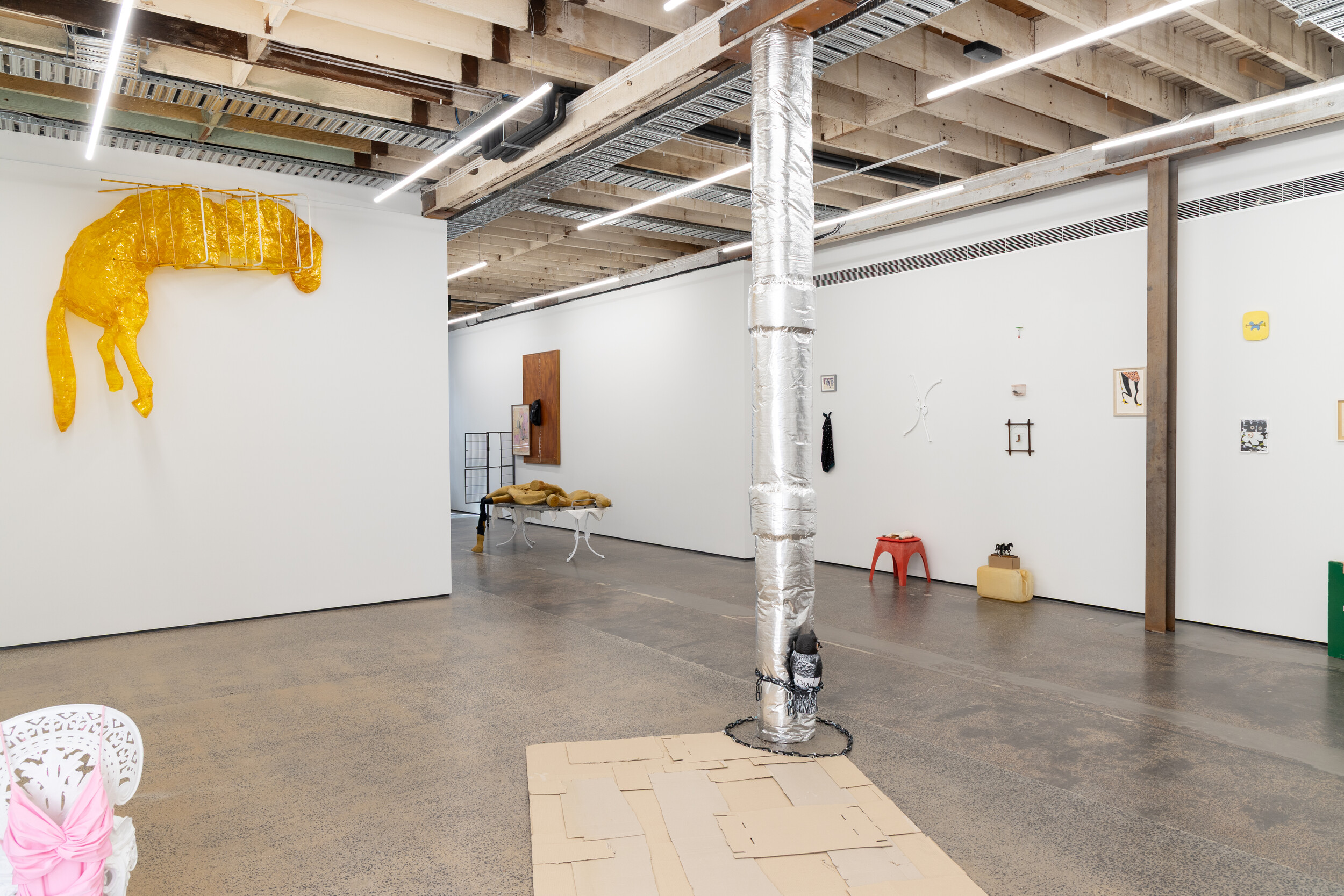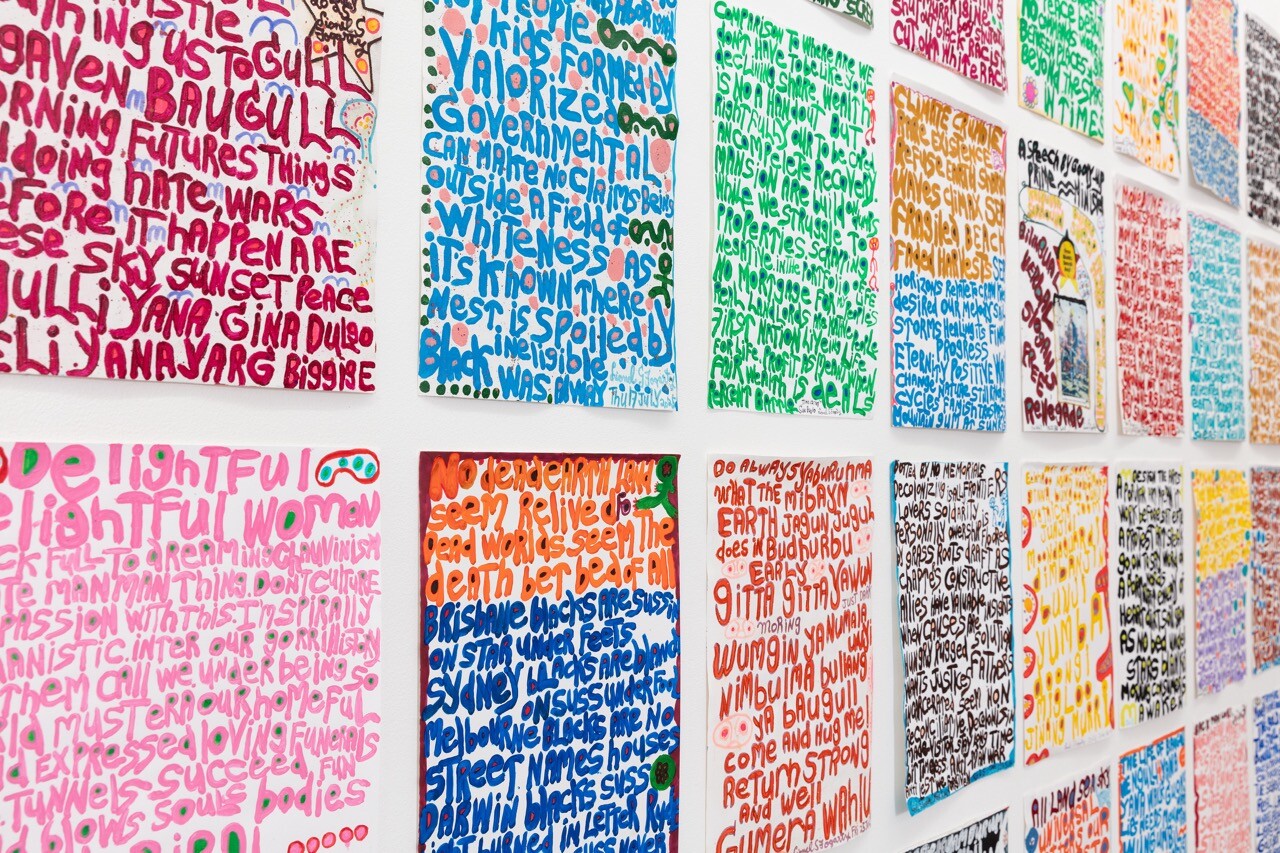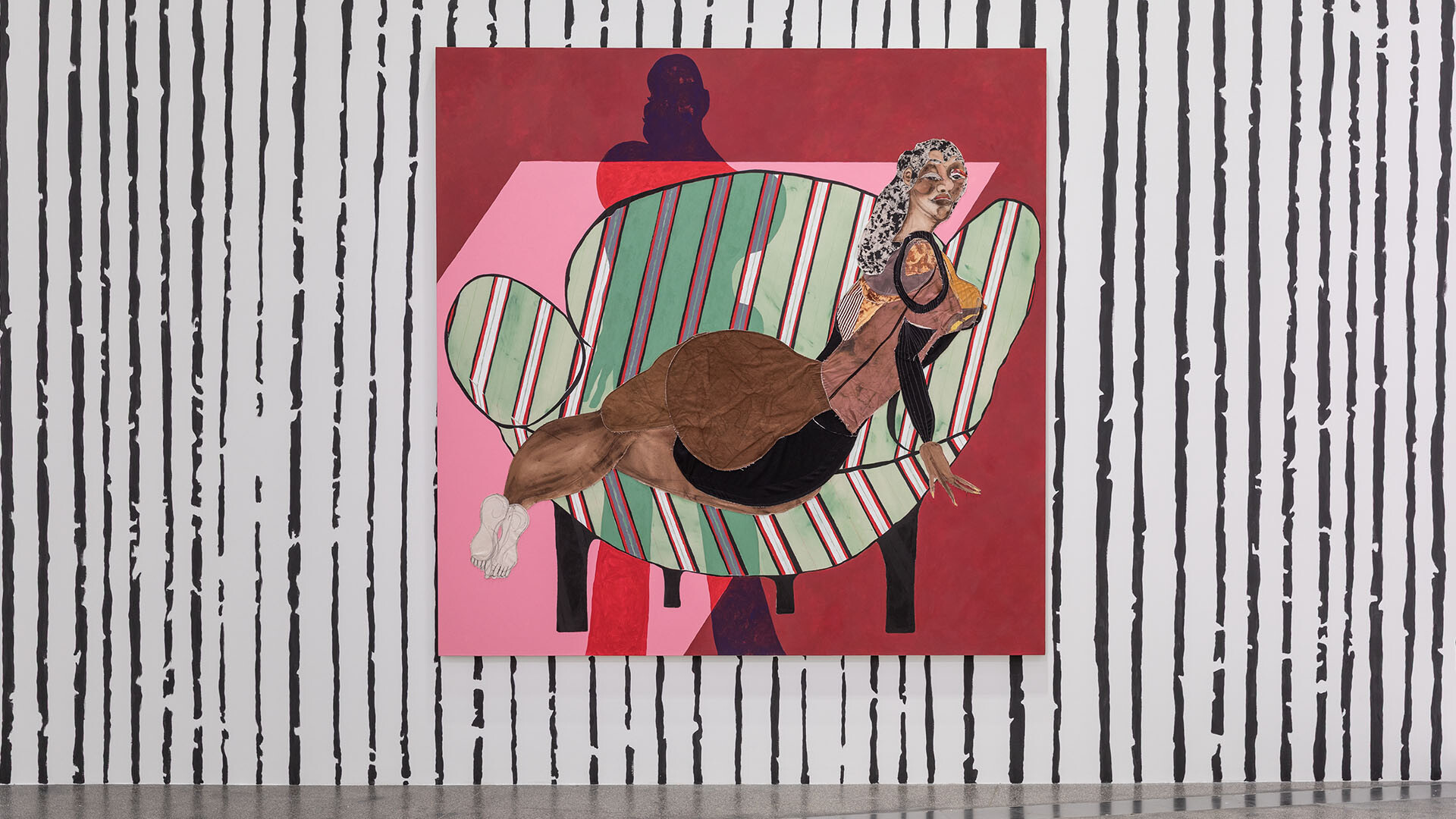Installation view of Agus Wijaya, ’~/alovelettertokala’, 2025, mixed media installation, dimensions variable, Passage Gallery. Photo: Jessica Maurer.
~/a_love_letter_to_kala
Jennifer Yang
The thing about opening a gallery in a vacant shopfront is that you inevitably surrender a little to the optics of commercial enterprise. But in this 1980s-era mall in Chinatown, the pittances paid are not so easily masked. These slim walkways were built for movement—of goods, capital, and the mall’s working-class frequenters, with aspirations of upward mobility—not for stillness; they were never about facilitating space but passage, if you will. This is intuitively understood by anyone attending a Passage exhibition opening; one is likely to end up filed into a line along its balcony, elbows pressed to the steel railing. Unlike public art in the usual sense, Passage’s concept of a 24/7 viewing experience is clearly offered on the basis of a “look, don’t touch” policy—a curious communion of a respect for the sanctity of the art object and a mercantile pragmatism. Passage’s current show is not exempt from this mode of looking and, luckily, it does not pretend to be. Tucked into a tidy row of hair salons, Chinese medicine shops, and restaurants, ~/a_love_letter_to_kala recognises that consumption, as a dominating impulse, guides not merely the work’s reception but the production of its very form. Rather than deferring to this impulse, however, Passage’s latest commissioned and exhibiting artist, Agus Wijaya, offers a way to endure its corrosive effects.
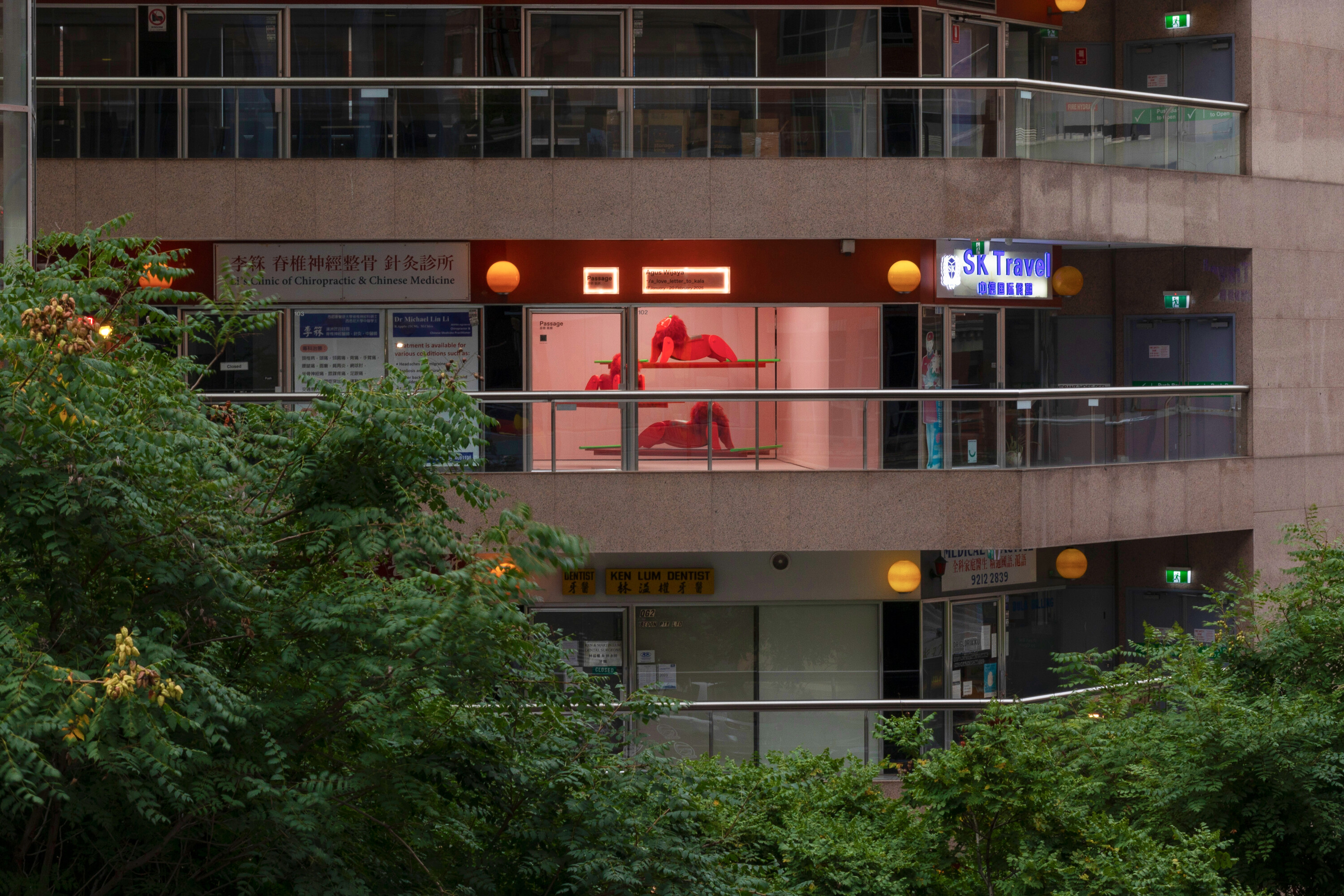
Installation view of Agus Wijaya, ’~/alovelettertokala’, 2025, mixed media installation, dimensions variable, Passage Gallery. Photo: Jessica Maurer.
No space, indeed not a well-meaning institution or even a not-for-profit, is free from conditions and contingency. A gallery, like Passage, supported with funding from the City of Sydney council is expected to respond to a set of stipulations. A gallery located in the Prince Centre at the heart of Chinatown likely finds itself beholden to an annual Lunar New Year (LNY) program.
With ~/a_love_letter_to_kala, Passage and Wijaya rise to the occasion. Three very red lions cascade downward from the ceiling, staunchly posed like rocking horses on floating rafts. Distended plastic masks, sculpted using computer software, rest on beds of artificial manes. Their dimpled faces are smiling, propitiously, like the Sanxing deities of Chinese folklore they were modelled after.
Wijaya’s favoured visual tropes prompt even the untrained eye to register commonplace markers of the Asian New Year. For many, Wijaya’s installation will call to mind the lion dance, with its long-standing association with Chinese-ness and New Year traditions transmitted across the Sinosphere, as well as variants of the tradition in other parts of Asia.
But there would have been no such thing as a New Year lion dance during Wijaya’s childhood. Chinese festivities and language were banned in West Java, where he grew up, during the terse political climate of anti-communist New Order Indonesia, a ban that lifted only after the fall of then-incumbent president Suharto at the turn of the millennium.
Still, the imagery in ~/a_love_letter_to_kala—like that in other LNY exhibitions cropping up in the Haymarket vicinity—will likely be conflated with hugely conspicuous and increasingly flattened images of a corporatised, pan-Asianist New Year. Neatly slotted into government-sanctioned, family-friendly programming and readily adorned by any luxury brand seeking to woo the Asian consumer, the corporate LNY image is far-reaching. But I am interested in how Wijaya conspires against it.

Installation view of Agus Wijaya, ’~/alovelettertokala’, 2025, mixed media installation, dimensions variable, Passage Gallery. Photo: Jessica Maurer.
First: a series of deflections. ~/a_love_letter_to_kala is obviously and memorably red. And yet this particular chroma of red—saturating wood, plastic, and synthetic fur—is insistently inaccessible. It does not quite settle into familiar hues of romance, eroticism, prosperity, and festivity, nor does it clue us into a sense of patriotism, blood, or violence. This red does not seem to reside anywhere in nature, but only here manufactured in Wijaya’s installation. To be sure, these are not the lions that ordinarily appear in nature either, but sisingaan: mock wooden lions hoisted up like makeshift palanquins during celebratory parades in Wijaya’s hometown, Cianjur, West Java, often with young children seated atop the effigies.
Sisingaan parades were rumoured to have originated as a tactful form of anti-colonial protest, which parodied the British and Dutch imperial coat of arms (lions were never native to Southeast Asia), and later practised more generally, typically to mark a child’s circumcision. The act of mimicry is morphologically constructed in the Sundanese term itself: Sisingaan takes the word for lion (derived from Sanskrit) as its root. Prefixed to the singa is its own reduplication (-si), and then, -an is suffixed to derive a new noun form so that the lion is transformed into something else entirely: a copy. Wijaya has developed a practice around the rendering of such “copies” or “fake versions” in digital prints and sculptures, for example, of the Garuda (an Indonesian nationalist symbol), military monuments, and an ever-expanding assortment of culturally loaded icons. Wijaya affectionately describes these copies as his jejadian or jadi-jadian (jadi meaning “to become”, which, by the same grammatical rule, becomes a bad imitation). In a Baudrillardian sense, Wijaya’s jejadian operate like simulacra, teetering on the edge of hyperreality. The sisingaan parade becomes a ritual observed, a ritual without clear origin, and one that has become self-referential as it moves through time and across geographical borders. In this conception of ritual and repetition as a form of movement, Wijaya’s sisingaan echo a shifting semblance of Chinese-ness as it drifts away from mainland China, is displaced again from its troubled malabsorption in New Order Indonesia, and is now oddly re-contorted into some pleasant form in Australia, where it will be mistaken for something else. Or, to put it another way, it will become something else.
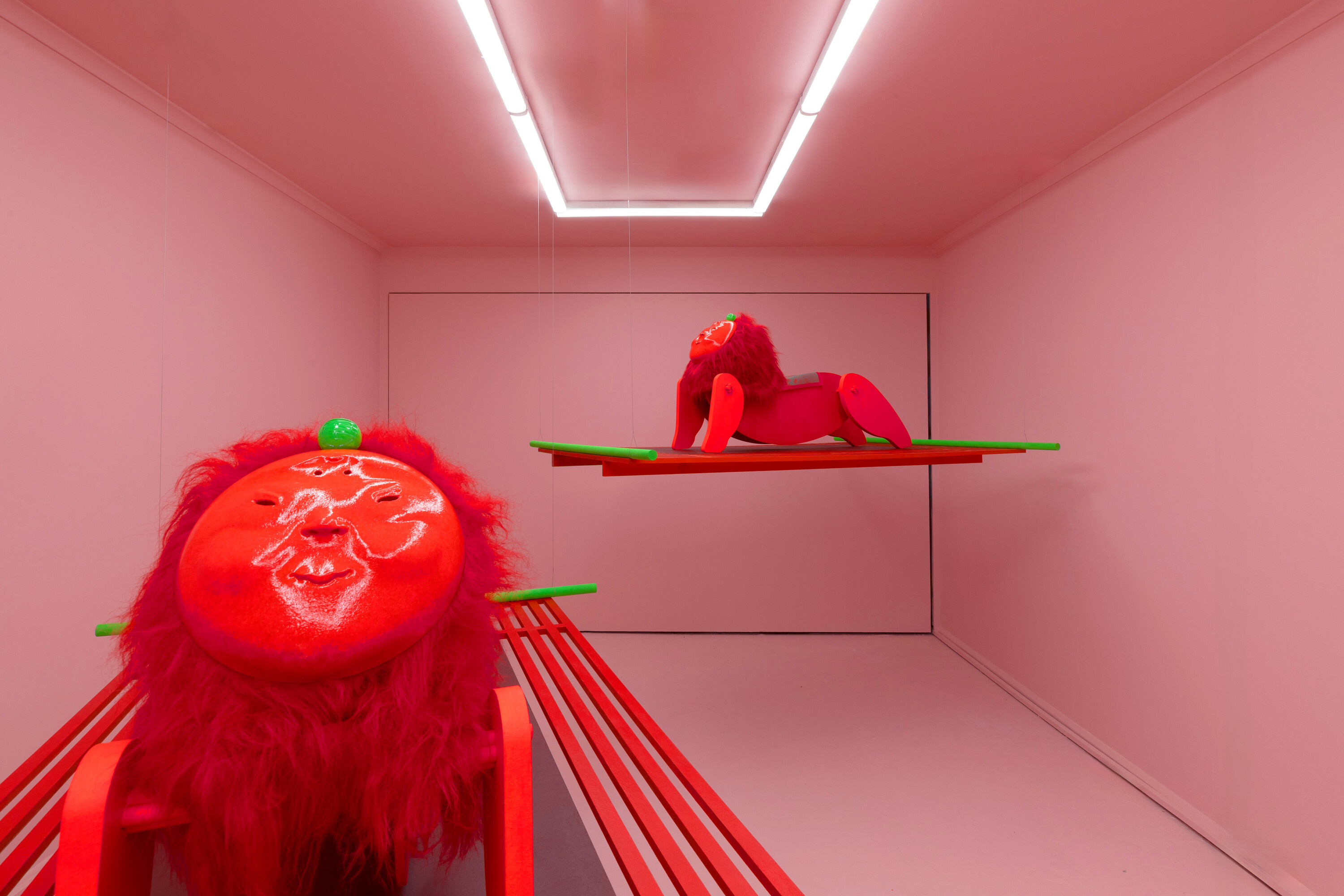
Installation view of Agus Wijaya, ’~/alovelettertokala’, 2025, mixed media installation, dimensions variable, Passage Gallery. Photo: Jessica Maurer.
Wijaya entertains this banality. He operates in a language of repetition, deviance, abstraction, and derivation, refusing to make a claim for the authentic. Even the pink that lovingly envelops the space can be considered a dilution or tint of red with white. He materialises a visual grammar of the bad copy and the fake, removed from its origins, which is obviously analogous to the Asian diasporic body and its anxieties. This is, indeed, at its ambivalent heart, what Wijaya offers us the shortcut code for, a love letter to Kala—not strictly in the sense of a deity of time and death in Hindu, Jainist, and Buddhist belief systems, but in a fuller acknowledgement of the Sanskrit word itself. Wijaya’s tribute to the passage of time concedes to time’s apogean manifestation: death, and, possibly, the death of the original itself.
I am not convinced, however, that Wijaya believes in a total hollowness at the core of his sculptural forms. Even as I write about the spatial economics of the mall, I cannot deny its populist appeal. Identity can be cultivated, projected, and reminisced over in the mall. A mall can be a place of sentiment. Wijaya says his sister used to work at the Prince Centre. His family used to see a travel agent on one of the floors. There remains an impulse to preserve the touch of the personal, the real, the intimate. Resting, soft, and languidly saddled over the sisingaan’s backs are digital prints on handkerchiefs. What appears to us as randomly generated warps and glitches, if you loosen the focus of your eyes, morph into family photographs of the artist as a child, about to eat a birthday cake, the artist’s parents, the artist’s daughters.
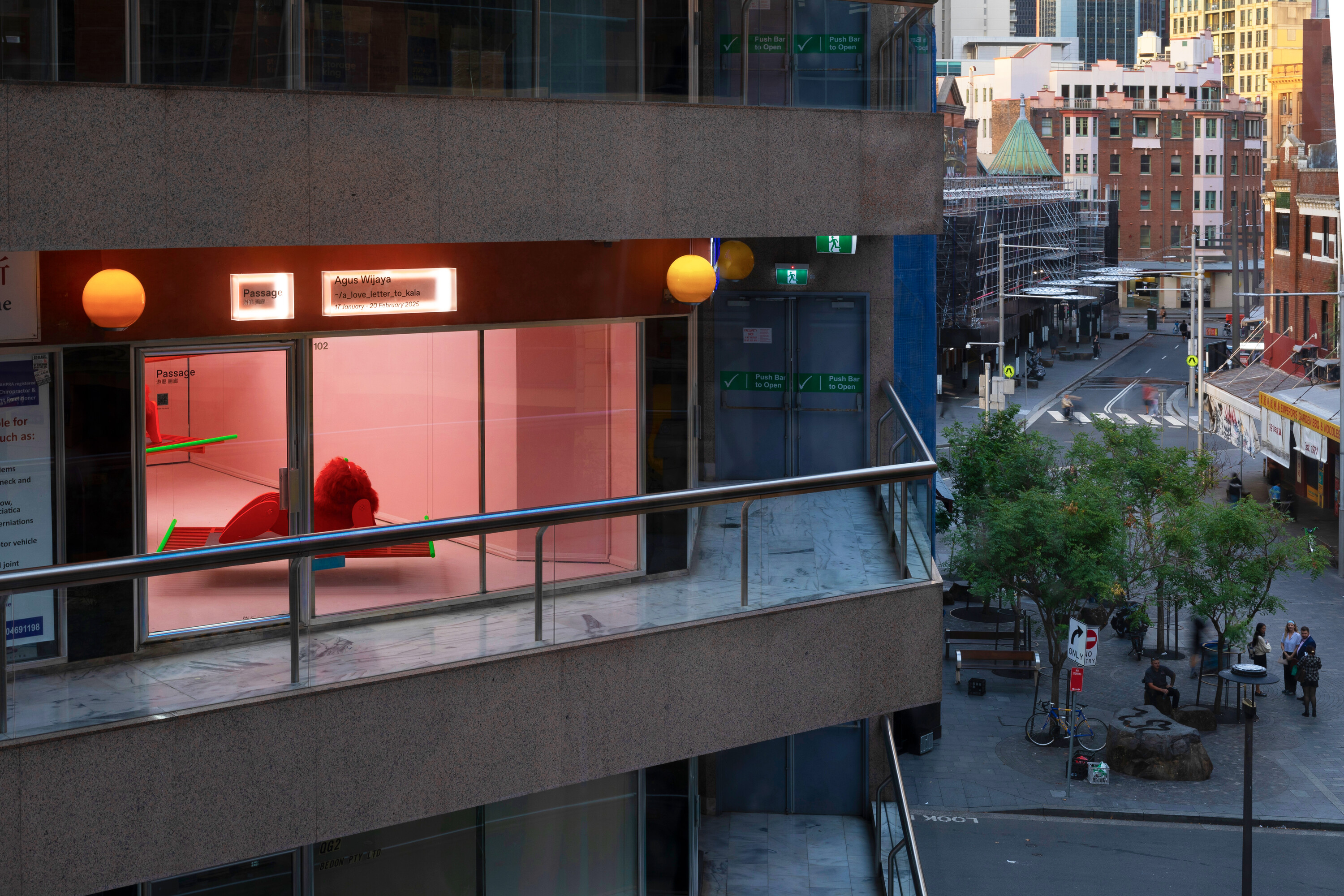
Installation view of Agus Wijaya, ’~/alovelettertokala’, 2025, mixed media installation, dimensions variable, Passage Gallery. Photo: Jessica Maurer.
In every choice to deal with one’s identity, a procedure of extraction is involved. In the work of art, we sometimes give this procedure another name, like celebration, reclamation, or translation. Those words can also be true. Wijaya trusts that the propulsive force of distance is not merely subtractive but generative also in its velocity. I do not doubt that his work is also about joy, that it never entirely relinquishes agency, nor does it let reality rot away even as it retreats. This is all in spite of us knowing that difference is easily snatched up and commodified; that one’s cultural identity can be brandished, performed, and fashioned into the fashionable; that the homogenising force of global capitalism is too often in collusion with a fickle multiculturalist ethics of diversity. We know that these forms cannot be separated from a systemically violent, perverse gaze in this settler colonial state. Perhaps this is why Wijaya is at pains to conceal. Unless the door to Passage is unlocked, and you manage to duck and manoeuvre your body around the sisingaan, the content of each handkerchief remains mostly inscrutable, even if not out of sight. Wijaya reveals so little that any singularity of meaning is abstracted away, diffused into these smiling leonine forms. So, even if just momentarily, we lose our hold on the easy markers of cultural identity we thirst for and a little shamefacedly rely upon. In this gleaming 24/7 window display, not everything is offered up for our consumption.
Jennifer Yang is a writer and curator working on Dharawal and Gadigal land. She is currently undertaking a PhD program at the University of Sydney.
